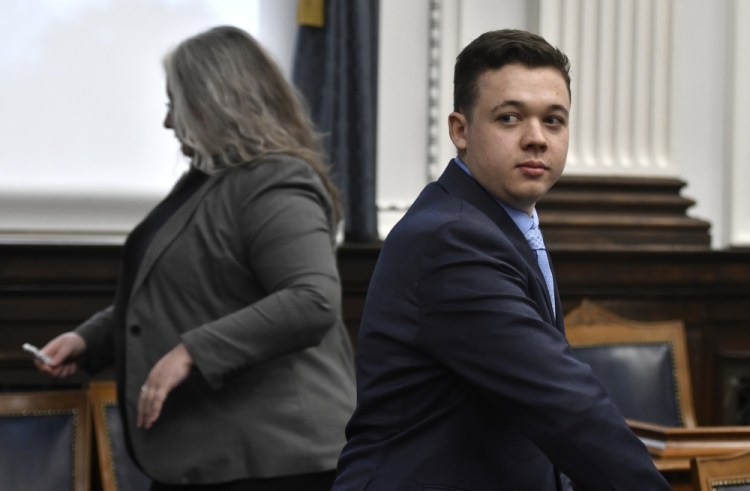KENOSHA, Wis. — Jurors will begin deliberations Tuesday at Kyle Rittenhouse’s murder trial after two weeks of testimony in which prosecutors and defense attorneys painted starkly different pictures of his actions the night he shot three men on the streets of Kenosha.
Prosecutors claimed in closing arguments Monday that Rittenhouse was a “wannabe soldier” who provoked bloodshed by bringing a semi-automatic rifle to a protest and menacing others, then walking off like a “hero in a Western” after killing two men and wounding a third.
But Rittenhouse’s lawyer countered that Rittenhouse acted in self-defense after being ambushed by a “crazy person” who he feared would wrest away his gun and use it to kill him.
Jurors listened to a full day of arguments before being told to return Tuesday morning for the start of deliberations in the case that has stirred fierce debate in the U.S. over guns, vigilantism and law and order.
Eighteen jurors have been hearing the case; the 12 who will decide Rittenhouse’s fate and the six who will be designated alternates will be determined by a drawing from a raffle drum.
Rittenhouse, then 17, shot two men to death and wounded a third during a tumultuous night of protests against racial injustice in the summer of 2020.
Rittenhouse said he went to Kenosha from his home in Antioch, Illinois, to protect property from rioters in the days after a Black man, Jacob Blake, was shot by a white Kenosha police officer. Rittenhouse, a former police youth cadet, is white, as were those he shot.
In closing arguments, prosecutor Thomas Binger called Rittenhouse a “wannabe soldier” who was “looking for trouble that night” — repeatedly showing the jury drone video that he said depicted Rittenhouse pointing the AR-style weapon at demonstrators.
“This is the provocation. This is what starts this incident,” the prosecutor declared. “You lose the right to self-defense when you’re the one who brought the gun, when you are the one creating the danger, when you’re the one provoking other people.”
Rittenhouse, now 18, faces a mandatory sentence of life in prison if convicted of the most serious charge against him, first-degree intentional homicide, which is Wisconsin’s top murder charge.
Binger zeroed in on the killing of 36-year-old Joseph Rosenbaum, the first man gunned down that night and whose shooting set in motion those that followed. The prosecutor repeatedly called it murder, saying it was unjustified and reminded jurors that Rittenhouse testified he knew Rosenbaum was unarmed.
Binger also said there is no video to support the defense claim that Rosenbaum threatened to kill Rittenhouse, and said Rittenhouse could have run away instead of shooting.
Binger also disputed the contention that Rosenbaum was trying to grab Rittenhouse’s rifle, which he said was not within arm’s reach when the first shot occurred. And Binger argued that once Rosenbaum was wounded, he was incapable of taking away the gun, which was strapped to Rittenhouse’s body, since he was falling to the ground with a fractured pelvis. Rittenhouse kept firing, delivering what the prosecutor called the “kill shot” to Rosenbaum’s back.
“I think we can also agree that we shouldn’t have 17-year-olds running around our streets with AR-15s, because this is exactly what happens,” Binger said.
In his own closing argument, defense attorney Mark Richards called Rosenbaum a “crazy person” who was “hell-bent on causing trouble that night” and went after Rittenhouse unprovoked.
“Mr. Rosenbaum was shot because he was chasing my client and going to kill him, take his gun and carry out the threats he made,” Richards said, adding that Rittenhouse never pointed his gun before being chased: “It didn’t happen.”
Richards said an enlarged image that prosecutors said shows Rittenhouse pointing his gun at protesters is “hocus pocus” that doesn’t prove anything.
After killing Rosenbaum, Rittenhouse shot and killed Anthony Huber, 26, and wounded Gaige Grosskreutz, 28, while trying to make his way through the crowd. Rittenhouse testified that Huber hit him with a skateboard and that Grosskreutz came at him with a gun of his own — an account largely corroborated by video and Grosskreutz himself.
The prosecutor said Huber, Grosskreutz and others in the crowd were trying to stop what they believed was an active shooter.
When it was all over, Rittenhouse walked away like a “hero in a Western — without a care in the world for anything he’s just done,” Binger said.
The defense, though, said Rittenhouse was set upon by a “mob.” Richards accused prosecutors of using the term “active shooter” for Rittenhouse because of “the loaded connotations of that word.”
Supporters have hailed Rittenhouse as a hero who took a stand against lawlessness; foes have branded him a vigilante.
Earlier Monday, Judge Bruce Schroeder dismissed a count of possession of a dangerous weapon by a person under 18, a misdemeanor that had appeared to be among the likeliest of the charges to net a conviction. It carries up to nine months in jail.
The defense argued that Wisconsin law has an exception related to the length of a weapon’s barrel. After prosecutors conceded Rittenhouse’s rifle was not short-barreled, the judge threw out the charge.
Perhaps in recognition of weaknesses in their case, prosecutors asked the judge to let the jury consider several lesser charges if they acquit him on the original counts. Schroeder agreed to do so as he delivered some 36 pages of legal instructions to the jury.
In his instructions, the judge said that to accept Rittenhouse’s claim of self-defense, the jury must find that he believed there was an unlawful threat to him and that the amount of force he used was reasonable and necessary.
With a verdict near, Gov. Tony Evers said that 500 National Guard members would be prepared for duty in Kenosha if local law enforcement requested them.
Comments are not available on this story.
Send questions/comments to the editors.


